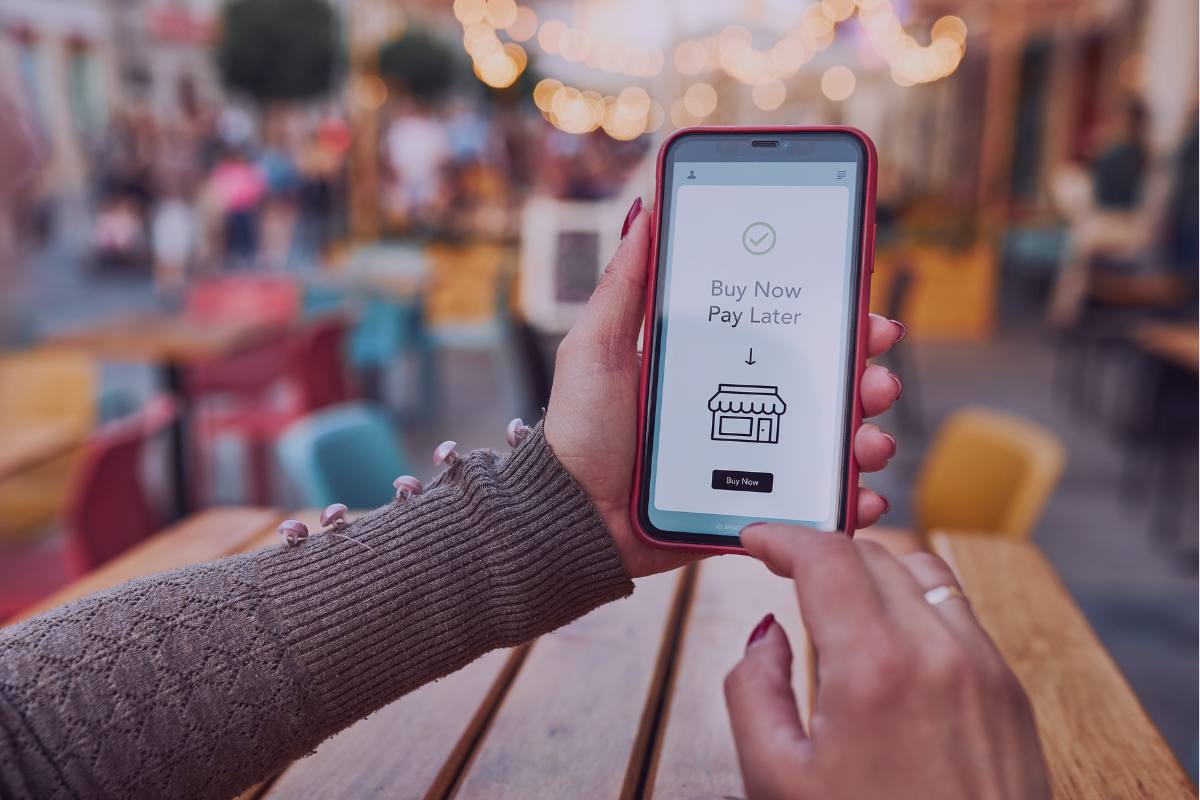The buzzing Buy Now Pay Later (BNPL) trend has not avoided it’s share of controversy. The FCA reported that 10% of the UK’s BNPL customers are already in arrears1. And there’s some concern2 among politicians that this risk will continue to spike. Labour MP, Stella Creasy, even went as far as to say BNPL services could be “the next Wonga waiting to happen”3. So, it’s easy to lump these firms in with the likes of loan sharks or sketchy credit providers. But we’re forgetting one crucial thing. Fintech plays the long game. BNPL is a small cog in a giant client lifecycle management machine.
Prioritising customers over banks
Beginning life over a decade ago, the BNPL concept started with the likes of Swedish Klarna and Australian Afterpay. As an alternative to high-interest credit cards, these payment options were designed to empower consumers. A lot.
Afterpay, for example, make their money by charging the merchant and not the customer. The customer only pays interest if he or she is late to pay back one of the four instalments over six weeks. This is two weeks longer than the average interest-free period for a credit card, helping to put the power squarely back in the hands of the spender.
What’s more, unlike traditional credit, customers are not encouraged to spend beyond their means. Quite the opposite. If a customer cannot pay an instalment with Afterpay, they are blocked from making further purchases. The business model is not designed to thrive from defaulting spenders, so there is little or no incentive to encourage this.
Today’s rush of new BNPL adopters stands on the shoulders of giants when it comes to consumer-first credit options. Firms like Klarna and Afterpay pioneered these new models designed to benefit the spender - rather than the bank - and help keep them in the black.
Avoiding debt spirals in times of need
The average amount spent via BNPL is around £654. These are small amounts of money. But historically, customers have felt compelled to turn to perilous pay day loans or bad credit, resulting in sky-high interest. Think back for example to Wonga who, at its peak, had a typical annual interest rate of 5,853%5.
BNPL seeks to avoid this. It can help customers bridge the gap interest-free when needed, and dodge debt spirals.
Perhaps this is the reason why the BNPL industry saw a boom over the COVID-19 pandemic, as so many people found themselves needing an urgent cash injection. In the UK, the BNPL market rocketed, nearly quadrupling over 2020 to become worth £2.7 billion6. Although, this figure is still dwarfed by the £250 billion of outstanding customer credit debt7.
Of course, there is a limit to how far ‘bridging the gap’ should go. It’s one thing to purchase a much-needed-item before pay day, and quite another to go on an unnecessary spending spree. That responsibility lies with the BNPL company, as well as the customer. In 2020, the UK’s advertising watchdog felt that Klarna had taken things too far, and banned an Instagram campaign aimed at young people to “treat themselves”8. It’s a clear warning to others not to go there. And recently in October 2021, Klarna was forced to back-peddle its wording, and ensure that consumers are crystal clear about what they’re signing up for9.
What’s more, the FCA are already drawing up strict rules and requirements to prevent bad debt, including affordability checks. The message is clear: credit is not to be entered into lightly. And any fintechs attempting to replicate the loan-shark way of doing things will be quickly slapped with a sanction.
Our Head of Compliance and Regulatory Affairs, Victoria Martin comments, “As part of the budget on Wednesday 27th October we are expecting the Chancellor to announce the next steps following the Woolard Review of innovation in unsecured credit, which will focus on regulating the buy-now, pay-later sector and is likely to bring it under the existing FCA unsecured lending framework”.
“In particular, we’re expecting to see more regulation around how firms evidence consumer understanding of BNPL products, responsible lending and credit information”, Victoria adds. “We hope that the proposed regulatory framework provides a proportionate balance of promoting adequate consumer protection whilst supporting innovation and growth in the buy-now, pay-later market”.
Introducing the brand to Gen-Z's
Incumbent banks, and particularly wealth managers, have made a huge error of judgement over the past few decades. They focussed too much on the customers with money, and not the young and struggling twenty-somethings. Fast-forward ten years and the now-wealthy generation of millennials have 50% less loyalty to their bank10. Ouch.
But fintechs have been quick to catch on to the importance of early loyalty. They’re not making the same mistake. Some have really taken this in their stride, as more than 40 fintechs on the market today are exclusively set up to serve young people and children11. And they work. It’s estimated that 39 million children and young adults worldwide plug into these apps12.
Services such as BNPL are largely aimed at younger adults, as living costs soar and salaries dwindle. And when it comes to retention and loyalty, it’s powerful stuff. After all, who wouldn’t love a brand that kept you above water when you were at your most financially vulnerable?
BNPL is surely not that profitable in the short-term. At least, not in terms of customer revenue. Especially as scores of financial services compete on interest rates, it’s looking more and more like a race to zero. What they do open the door to, however, is a fierce long-term customer loyalty. Which is worth so much more than an interest-rate fraction of £65.
Building up a one-stop-shop for financial services
Of course, BNPL is just one tool in the kit for many of today’s fintechs. Take Revolut, for example, Britain’s most highly valued fintech at $33 billion13. CEO Nikolay Storonsky recently unveiled plans for a mobile button which would switch the debit card into a BNPL card14.
But this would be just the latest in a whole suite of products. Revolut users can exchange currencies, speculate on the stock market, purchase crypto-assets, book holidays, claim cash-back, buy insurance, send mobile gift-cards and much more.
Likewise, rival BNPL providers including Curve, Monzo, Amazon, Apple Pay and more are also creating a supermarket of services which customers never need to leave. BNPL is just another shopping aisle. And the winner of this one-stop-shop of financial services takes all. All current accounts, saving pots, investments, insurance, credit … the lot, hosted on one platform. Making BNPL less of a loan and more part of a 360-degree service.
"BNPL is less of a loan and more of a feature in the embedded finance ecosystem”, comments 10x Banking’s Director of Product and Engineering, Leigh Pepper. “Most banks will be able to replicate the lending aspect of enabling a repayment schedule for a transaction amount over three or four payments, it’s likely this will actually become a common feature of most current accounts over the next few years”.
“Where BNPL becomes embedded finance is if you have the merchant checkout,” Leigh continues. “There are only so many buttons you can put on your payment page, so Klarna, Afterpay and Affirm – with their Amazon deal – definitely have first-mover advantage."
“The Super-app that enables customers to leverage exclusive merchant offers, discounts and improves the volumetrics for the merchant (a simple debit card to loan flick) is neat as a feature but consumers want more”.
Looking beyond the cash, at the customer
Putting all these benefits and strategic marketing aims together, it’s little wonder that so many financial services are jumping on the BNPL bandwagon. Curve and Monzo were so keen that they launched their products on the same day with the same name*.
Customers like it too. After getting a taste in 2020, the trend has continued, and transactions are expected to double over the coming years15. By 2024, it’s predicted that a staggering 10% of all UK transactions will be conducted via BNPL.
Today even incumbent banks such as Barclays, Goldman Sachs, Commbank and Citi are all rumoured to be investing in BNPL. What’s more, Visa has launched an API for BNPL, which financial services can plug into16. Everyone and their dog seem to be offering some form of BNPL. Those who delay, will surely be left behind and wondering where all the customers went.
As BNPL rockets into the mainstream, merchants and financial services should be careful that the cost does not ultimately boomerang back to the customer. Consumers who are wise to the tricks of marketers will surely not take kindly to this. They want a service which is transparent and always puts them first.
In a crowded market, it’s customer centricity that sticks. Not short-term profit grabs. Like so many other fintech strategies, this latest customer convenience seems to so much more than just a new product. It’s part of a much bigger picture to secure market dominance, with well-rounded service and no reason to ever leave the app.
* Awkward co-incidence? Or clever “who wore it best” marketing ploy? We’ll let you decide!
|
1 Source: FCA 2 Source: The Guardian 3 Source: The Guardian 4 Source: The Guardian |
5 Source: This is money 6 Source: FCA 7 Source: FCA 8 Source: MoneySavingExpert |
9 Source: Financial Times 10 Source: Mediapost 11 Source: Fintech news 12 Source: Fintech news |
13 Source: Finextra 14 Source: Finextra 15 Source: Belfast Telegraph, taken from World Pay 16 Source: Finextra |



.jpg)